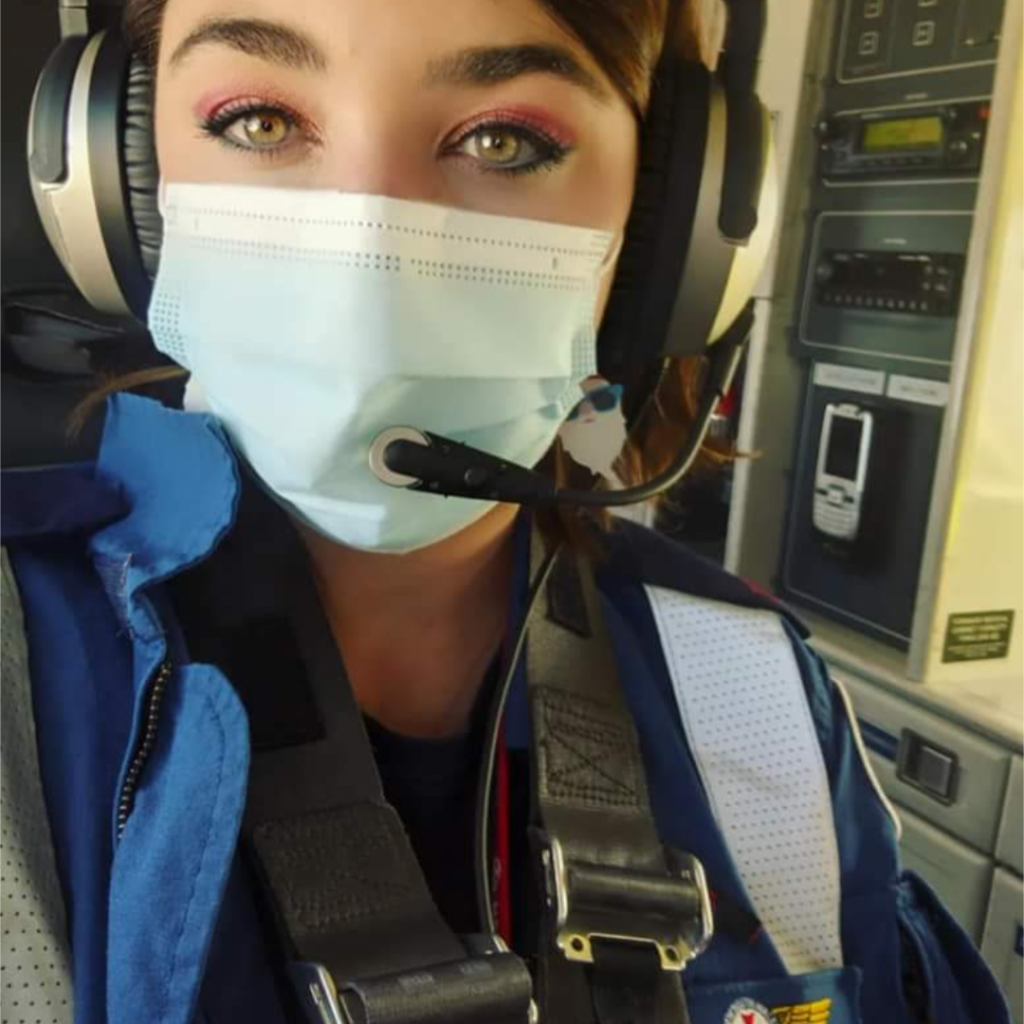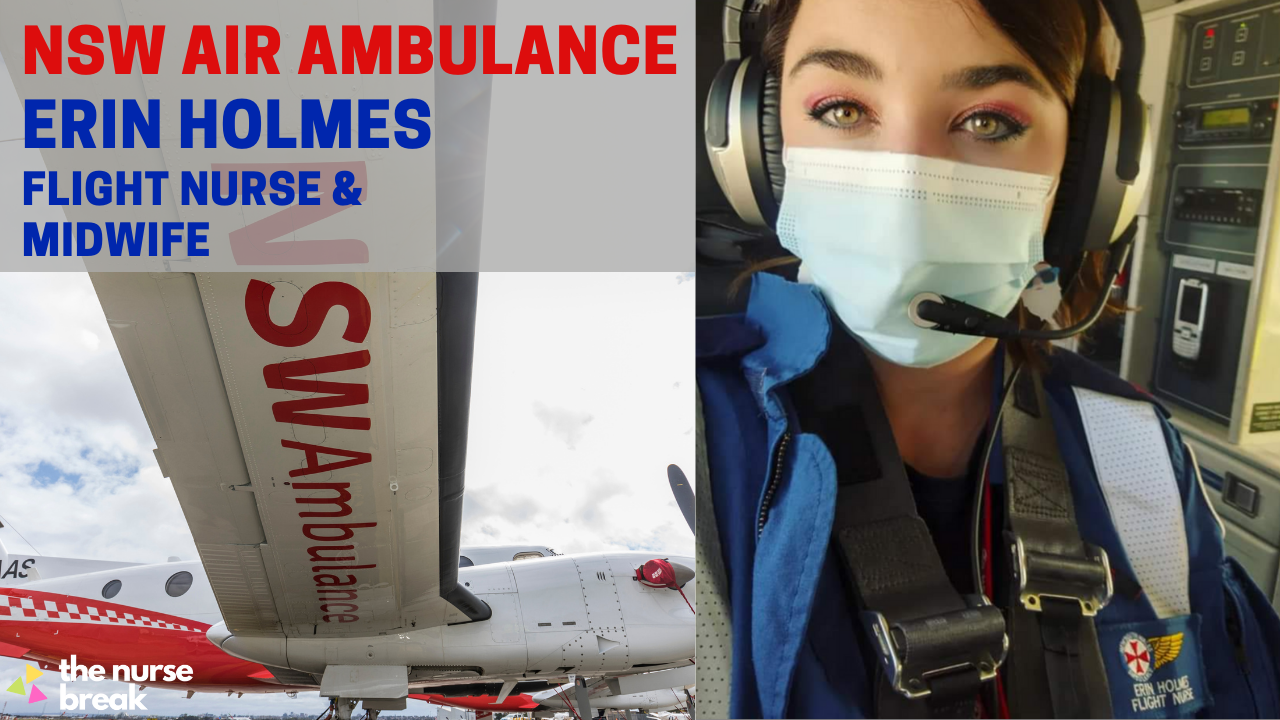Table of Contents
We teamed up with NSW Air Ambulance, to interview some of their Flight Nurse / Midwives about their careers and roles. We are excited to bring you this interview with Erin Holmes who has kindly shared her experience as an NSW Air Ambulance Flight Nurse / Midwife. If you’re a nurse with midwifery and critical care experience then the NSW Ambulance Service wants to hear from you – go here.
How did you get into flight nursing with the NSW Air Ambulance?
Hey everyone, my name is Erin Holmes and I’m one of the new flight nurses with NSW Air Ambulance. I originally grew up in Canberra where I started my training in nursing and paramedicine at ACU. During my training, I attended an international health development project in Battambang, Cambodia where I worked in rural health centres and orphanages. After graduating I worked in a private ambulance company attending motorsport trauma at racetracks and did my grad year at Canberra Hospital where I worked in the bariatric suites and gastro-surgery. In 2015, inspired by my time in Cambodia, I created and lead a team of 15 people to accompany me on a project to Nepal to help after their devastating earthquake that year.
My husband and I then moved to Sale in rural Victoria, where I broadened my nursing experience in Emergency, Critical Care, Paediatrics, Neonatal and Med/Surg nursing. While in Sale, I completed a graduate diploma of midwifery, and worked for a little while as a midwife, before moving to Sydney to gain more tertiary experience in labour wards. One of my paramedic friends saw the position with NSW Air Ambulance advertised, and knowing it was something I always wanted to do, she shared it with me and I applied. Within a whirlwind few weeks, I had quit my job and was beginning my training in aeromedical nursing.



What kinds of aircraft do you travel on?
NSW Air Ambulances uses a fleet of Beechcraft 350 King Airs, capable of taking two stretcher patients and any required medical teams for their care. We can facilitate the transfer of many patients with specialised requirements from the youngest tiny premature neonates, patients requiring ventilation or ECMO, bariatric patients, complex trauma patients, women with obstetric emergencies or patients requiring medical retrieval.
What does a typical day look like for you?
I think the best part of this job is that there isn’t always a “typical day” at work. You can be sent at short notice, to a whole range of locations anywhere in NSW and surrounds. At the beginning of the shift, you check in with Ambulance Control who let you know if there are any flight plans for you. Once you have a flight plan, you have to review it and make sure the logistics are going to work for you, your pilot and your patients. You might have multiple patients across multiple destinations, so you contact the referring hospitals to triage your patients and try to stabilize them for flight and provide them with a timeline for the transfer.
You contact your pilot for a pre-flight brief and alert them to any requirements you might have for the flight, such as the setting of your cabin altitude or need for medevac (priority air traffic categorisation), and they will alert you to any aviation risks relevant to the flight. You then prepare your stretchers, gather any equipment specific to your patient, before doing a pre-flight check. Then you’re off and ready to go. A-typically, you may be contacted by ambulance control on the satellite phone to divert to higher priority cases, or you may need to escalate and expedite care for your patient if they deteriorate in flight.
Did you get any specific training?
Before you’re checked to line as a flight nurse you undertake six weeks of training to get you ready for the role. This includes supernumerary flights with other senior flight nurses and educators, aviation physiology lectures and assessments, learning packages, skill competencies, aircraft equipment training and standard aviation safety requirements like dangerous goods, and emergency procedures training.
What are the main types of patients you care for?
Our patients are primarily transferred for tertiary care or access to higher level imaging and intervention. Most common presentations typically include cardiac, neurological, endocrine, gastro-intestinal, trauma, obstetric, or paediatric/neonatal. A flight nurse will take up to two patients simultaneously as a sole clinician, unless the patient is acutely unwell and it is deemed safest for the patient’s care to have an additional flight nurse or doctor on board.
The flight nurse is able to work from a large range of ambulance protocols, procedures, and pharmacology to treat patients during transfers, and commence or maintain additional treatment under the guidance of the State Retrieval Consultant or Hospital orders.
What are some unique clinical considerations that flight nurses need to make?
We are required in our pre-flight assessment of each patient to consider how the stressors of flight could affect the patient physiologically. In an aviation environment, patients are exposed to gravitational forces, reduced humidity, reduced partial pressure of oxygen at altitude, vibrations, environmental exposures, barometric pressure, motion sickness, and aircraft noise.
It is the nurse’s responsibility to understand the basics of gas laws and the physiology of what these stressors impose on patients, so that we can request appropriate cabin requirements from our pilots for the safety of our patients.
Explain some common misconceptions about flight nursing in your opinion?
I think the biggest misconception I hear from people unfamiliar with our work, is the assumption that we always work with doctors on our transfers. I think our autonomous practice and the scope of practice we can work within is something that surprises many, but it is not without years of experience and training behind us.
Can you tell us about the most rewarding and difficult aspects of your area of work?
For me the most rewarding part of this job is knowing that I’m taking people to care they could otherwise not receive and provide them with access to timely healthcare options (through expedited transfers), that would otherwise not be an option to them if the transfer had to be attended by road.
A challenge we face is when transferring people from non-English speaking backgrounds. Access to interpreting services is difficult when the majority of your time is spent out of reception and Wi-Fi. In transfers like this, I have found it so important to use your time on the ground wisely, and plan ahead writing down basic communication terms in their language that can assist me with their care in flight, such as; pain, sick, toilet etc.
What is your relationship with grief, trauma and death albeit all different things?
I imagine every nurse would have a complex answer to this. For me personally, it is something I have grown more comfortable with, as I’ve become more experienced as a nurse. It is my personal belief that every person deserves dignity in passing, and to be able to give them a comfortable and pain free death is very important to me.
One of my most memorable transfers to date was of a man that deteriorated after his tertiary procedure was unsuccessful. He was dying, and our flight was planned to try to get him home to see his family before he passed. I was anxious how the stressors of flight would affect someone that was physiologically shutting down, but we managed to get him home for his family before he passed away.
I think many people think of grief as just the physical loss of a close relationship in their life. However nursing has shown me that it can be so much more than just that and is triggered from so many things like the loss of ability/function, connection, security, memories, or even the plans you had for your future.
I think health care professionals underestimate the trauma that we take on and inherit through our work, and I think it is for this reason that it is so important that we reach out to each other and our close relations for support, and utilize employee assistance and counsellors to ensure this burden doesn’t deepen and begin to affect other areas of our lives.
What are the skills or experiences required by nurses prior to considering a job in flight nursing?
Flight nursing requires a person to be dual registered in nursing and midwifery through AHPRA and have additional qualification and experience in critical care and emergency medicine. It is important that a flight nurse is able to work autonomously and independently, but to also be able to integrate and function well in a team.
What do you wish you knew before you started flight nursing?
I’ve had such a varied nursing and midwifery career which is wonderful and has had me caring for all age groups from premature infants in the Special Care Nursery to 102-year-olds in nursing homes. While this definitely aids in my work as a flight nurse, it means that I never feel like an expert in any particular speciality.
So while I wouldn’t change anything about the career progression I’ve had, and I love the experience I’m gaining over my time as a flight nurse, I would have liked to know more about the work we do so I could have gained more experience in those specialities prior. But maybe that’s just the overachiever in me…
Can you think of a really funny situation you’ve had while working?
Honestly, just funny moments between colleagues. The camaraderie in this job is really nice, and you become really close with colleagues as you do the ground duties on the base when returned from or prior to flights. I haven’t been in this job long enough for too many of my own funny stories, but the senior flight nurses have plenty to tell.
Why should people consider a job with NSW Air Ambulance?
Becoming a flight nurse allows you to upkeep many scopes of practice, lets you see places far and wide, gives you a different office space every day, and allows you to spend focused attention on a smaller number of patients. It lets you practice autonomously and demonstrate critical thinking. It gives you logistical challenges, and broadens your communication. It can be fun, empowering, and challenging, and I believe it is a great career to consider.
What’s next for your career?
Honestly, I don’t know. But I know it will be an adventure!






You must be logged in to post a comment.